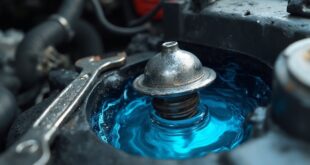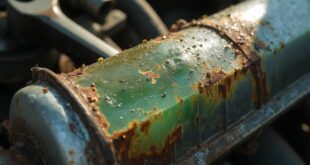If your car won't start due to a bad starter, try checking the battery and connections first. Then, gently tap the starter to help it engage. You can also jump-start the car using jumper cables. Inspect the solenoid wire and consider bypassing it. If possible, push-start the car if it's a manual. Don't forget to examine ground connections and, if all else fails, replace the starter. Keep going to uncover more handy tips and tricks!
Check the Battery and Connections
Before diving into more complex troubleshooting, start by checking the battery and its connections.
Verify the battery's charged; a weak battery can cause starting issues. Look for any looseness in the terminal connections—tighten them if necessary.
Inspect the battery terminals for corrosion; if you see any, clean them with a mixture of baking soda and water.
Next, trace the positive wire to the starter, confirming it's secure. A quick shake of the wire can reveal any loose connections.
These simple checks can save you time and effort before moving on to more involved diagnostic steps.
Tap the Starter
If your car won't start, try gently tapping the starter. Sometimes, a starter can get stuck due to dead spots, and a light tap might help it move past them.
Use a hammer or a ratchet extension, but remember to be gentle—don't bang on it. Before you try this, make sure your vehicle is in neutral for safety.
A well-placed tap can sometimes give the starter just enough encouragement to engage. After tapping, turn the key to see if the engine cranks.
If it doesn't, you may need to explore other troubleshooting options.
Jump-Start the Car
When your car fails to start due to a bad starter, jump-starting it can provide a quick boost to get you back on the road.
Grab a pair of jumper cables and find a working vehicle. Connect the positive terminals first, then attach the negative terminals.
Give the battery a few minutes to charge before trying to start your car. Keep in mind that this method may not permanently fix the issue, but it can help you get going temporarily.
If the car still doesn't start, you might need to explore other solutions or consider professional assistance.
Inspect and Bypass the Solenoid Wire
Inspecting the solenoid wire is essential for diagnosing starter issues. First, check for debris or loose connections along the wire.
If everything looks good, you can bypass the solenoid wire by connecting it to a 12V current. Listen for a clicking sound when you do this; if the starter spins freely without engaging, you might've a solenoid problem.
For a more direct approach, use a screwdriver to connect the solenoid terminal to the starter positive terminal. This method sends power directly to the solenoid, allowing for circuit closure.
Always exercise caution when performing these steps.
Push-Start the Car
After checking the solenoid wire, you might find that your vehicle still won't start.
If you have a manual transmission, you can push-start the car. Gather a couple of friends to help push the vehicle. Once you reach about ten mph, quickly shift into second gear and release the clutch. This should engage the engine and get it running.
Be ready to try multiple times if it doesn't work initially. Remember, while this method can get you moving, it's important to address the underlying starter issue to prevent future problems and drivetrain wear.
Examine Ground Connections
To guarantee your car starts reliably, examining ground connections is essential, as poor grounds can lead to intermittent starting issues.
First, check the ground connection from the starter to the transmission for any damage. Look for loose or rusty wires connected to the car body and ascertain there's a solid ground between the battery and the body.
You can use an external jumper cable to test the engine ground connection. Tightening or cleaning any affected connections can greatly improve your starter's performance.
A secure ground prevents open circuits, reducing the risk of starting problems.
Replace the Starter
Replacing the starter is an essential step when you've confirmed that it's the source of your car troubles.
First, gather your tools: a wrench and a socket set. Disconnect the battery to guarantee safety.
Next, remove the mounting bolts and electrical connections from the faulty starter. Carefully take out the old starter and install the new one in reverse order.
Make sure all connections are secure. Once everything's in place, reconnect the battery and test the new starter to verify proper operation.
This straightforward process can save you time and money, getting your car running smoothly again.
Frequently Asked Questions
Can a Bad Starter Drain the Car Battery?
Yes, a bad starter can drain your car battery. If it struggles to engage, it may draw excessive power, leading to a weak battery. Regularly check your starter to prevent battery issues and guarantee reliable performance.
What Tools Are Needed for Starter Replacement?
You'll need a wrench, socket set, and possibly a screwdriver for starter replacement. Make sure to have safety gloves and goggles handy, too, for protection while working on your vehicle's electrical system.
How Can I Tell if the Starter Is Truly Bad?
To determine if your starter's bad, listen for clicking sounds when you turn the key, check if dashboard lights dim, and see if the engine fails to crank or starts slowly.
Is It Safe to Drive With a Failing Starter?
It's not safe to drive with a failing starter. You risk being stranded, as it can fail completely at any moment. Address the issue promptly to guarantee your vehicle remains reliable and functional.
How Long Does a Starter Typically Last?
A starter typically lasts between 100,000 to 150,000 miles, but factors like driving conditions and maintenance can affect its lifespan. Regular checks can help you catch issues early and extend its durability.
 Car Service Land Coupons for Oil change, Tires, Wheel alignment, Brakes, Maintenance
Car Service Land Coupons for Oil change, Tires, Wheel alignment, Brakes, Maintenance




